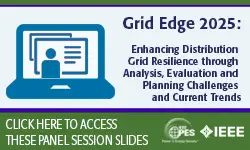Detecting Large Frequency Excursions in the Power Grid With Bayesian Decision Theory
Amanda Lenzi, Julie Bessac, and Mihai Anitescu
-
Members: FreePES
IEEE Members: Free
Non-members: FreePages/Slides: 10
20 Jan 2022
Disturbances in power systems, such as a generator trip, affect the frequency and voltage of the power grid. A framework that enables anticipating potentially dangerous frequency excursions (as signs of the disturbance start to reach sensors) is crucial to allow the operator more time to maintain or improve the electrical system's reliability. We propose statistical models for anticipating disturbances in the frequency response at several locations simultaneously, and we quantify the risk of a frequency excursion. After probabilistic forecasts of the power grid frequency are obtained, a Bayesian decision framework is developed to issue real-time event recommendations based on actions that minimize the risk over some loss functions predefined by stakeholders. A case study with real-time monitored data from the FNET/GridEye system shows that the traditional autoregressive models underestimate the uncertainty, leading to high chances of missing a rapid frequency drop. On the other hand, this case study reveals the value of including spatial dependence in the model. The proposed spatiotemporal model better captures the uncertainty and significantly increases the probability of identifying large frequency excursions. Results show that the spatiotemporal model can significantly reduce risks for the system operator as it consistently indicates lower costs than the ones from classical models for a wide range of loss functions.


